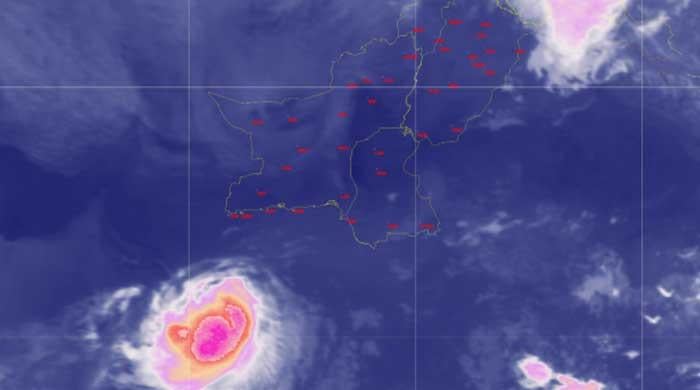Entertainment
Cyclone Shakti unlikely to hit Sindh, will bring light rain to coastal areas: PMD

- Storm moving West-Southwestward, says Met Office.
- Cyclone Shakti is located 480km southwest of Karachi.
- Winds of 40-55 km/hr expected along Sindh’s coast.
KARACHI: The severe cyclonic storm Shakti, currently swirling over the northeast Arabian Sea, is not expected to make landfall along Sindh’s coast, The News reported on Sunday.
The Pakistan Meteorological Department (PMD) has said that the cyclone, however, will bring rough sea conditions, strong winds, and light rain to coastal districts over the weekend.
According to the Met Office’s Tropical Cyclone Warning Centre in Karachi, Shakti was located about 480 kilometres southwest of Karachi on Saturday evening.
The storm has been moving west-southwestward and is likely to track further into the northwest and adjoining central parts of the Arabian Sea before curving east-northeastward by late Sunday.
Meteorologists expect it to gradually weaken after recurving, reducing the threat of any direct landfall in Pakistan.
The PMD said that although the cyclone poses no immediate danger to Sindh’s coastline, its outer rain bands may cause isolated showers in Badin, Thatta, Sujawal, Hub, Lasbela, Awaran, and Kech districts.
Karachi is expected to remain partly cloudy and humid, but moderate to heavy rainfall is unlikely unless the system shifts closer to the coast.
Sea conditions, however, are expected to remain dangerous for small boats and fishing vessels.
Squally winds of 40 to 50 kilometres per hour, gusting up to 55 kilometres per hour, are expected along the Sindh coast, while near the centre of the storm, gale-force winds could reach 120 kilometres per hour with gusts up to 135 kilometres per hour.
The PMD has strongly advised fishermen to avoid venturing into deep-sea waters until at least Sunday evening.
Explaining the cyclone’s dynamics, weather experts said Shakti formed due to intense convection over warm sea surface temperatures exceeding 31°C in the northeast Arabian Sea — a common condition for cyclogenesis in early October.
The system intensified rapidly into a “Severe Cyclonic Storm” as it drew energy from moisture-laden air and the warm upper ocean layer.
However, the presence of strong upper-level wind shear and drier air to its north is expected to weaken it gradually once it moves toward cooler waters.
“Cyclone Shakti is not on a track to strike Sindh directly, but it will create hazardous sea conditions and intermittent rain in some coastal areas,” said a senior PMD official. “We are continuously monitoring its trajectory and intensity, and further advisories will be issued as the system evolves.”
Satellite imagery on Saturday showed dense cloud clusters around the storm’s eye and spiral rain bands extending outward, indicating sustained strength at sea. By late Sunday, Shakti is expected to move east-northeastward and lose intensity, becoming a deep depression before dissipating over open waters.
Authorities, including the Provincial Disaster Management Authority (PDMA), Pakistan Navy, and coastal development agencies, have been alerted to remain vigilant and ensure preparedness in case of sudden changes in the storm’s path or intensity.
Meteorologists noted that the Arabian Sea has seen an increase in cyclonic activity in recent years, largely attributed to rising sea surface temperatures and changing climate patterns.
While most systems veer away from Pakistan’s coastline, the risk of high tides, storm surges, and coastal flooding remains significant for vulnerable fishing communities along Sindh and Balochistan.
Residents of coastal areas have been urged to stay informed through official PMD updates, avoid unnecessary movement near the shoreline, and ensure small boats are securely docked until weather conditions stabilise.
Entertainment
Jon M. Chu talks journey to "Wicked: For Good," casting Colman Domingo as Cowardly Lion

“Wicked: For Good” director Jon M. Chu joins “CBS Mornings” to talk about the highly-anticipated movie, his journey to working on the films and casting. The movie takes place right before and during the events of the 1939 movie, “The Wizard of Oz.”
Source link
Entertainment
Bottlenose dolphins spotted in Gwadar West Bay

ISLAMABAD: A large pod of bottlenose dolphins was sighted in Gwadar’s West Bay, a rare visual treat captured by observers and described by World Wildlife Fund-Pakistan (WWF) as an “encouraging sign of ocean health”.
According to WWF-Pakistan, bottlenose dolphins are commonly found in the country’s coastal waters, with schools frequently seen near the Indus Delta, Chiran Island, Ormara, Astola Island and the broader Gwadar region.
Pakistan’s waters are home to 27 species of dolphins and whales, reflecting a rich level of marine biodiversity.
WWF-Pakistan said that repeated sightings of dolphin schools point to the strong productivity of the northern Arabian Sea.
However, the organisation stressed the need to protect Pakistan’s fragile marine ecosystem through awareness and effective management measures aimed at safeguarding dolphins and other marine life.
The conservation body reiterated that rising visibility of marine fauna should prompt renewed efforts to preserve habitats and ensure sustainable use of coastal resources.
Entertainment
Here’s what’s really at stake

The Brazilian presidency of the COP30 climate summit has revealed the first draft of a crucial decision text.
Dubbed the “Mutirão” decision, the draft outlines a starkly different options on the key issues that have dominated talks in the humid Amazon city: transitioning away from fossil fuels, providing climate finance, and managing trade disputes.
On the critical issue of fossil fuels, the text reveals a deep rift.
One option encourages countries to develop “just, orderly and equitable transition roadmaps,” but stops short of endorsing a global phase-out plan backed by over 80 nations.
A weaker alternative merely invites countries to share “success stories” on moving toward low-carbon solutions. Tina Stege, climate envoy for the Marshall Islands, called the current language “weak” and insisted it “must be strengthened.”
The financial negotiations are equally divisive.
The draft includes a proposal to triple adaptation finance for developing nations to $120 billion a year by 2030, a key demand from vulnerable countries.
However, developed nations are pushing back, with alternative options that only acknowledge the need to “dramatically scale up” funding without binding targets.
In a historic first for a UN climate text, trade also features prominently, reflecting pushback from China and India against carbon border taxes.
Proposals range from establishing new dialogues to an annual UN summit on trade and climate.
As ministers arrive for the final high-level negotiations, the choices are clear. “Countries can get behind the stronger elements… or move in a weaker direction and water down what they come away with from Belém,” said David Waskow of the World Resources Institute.
The success of the entire “Belém political package” now hinges on bridging these deep divides before the conference concludes.
-

 Tech1 week ago
Tech1 week agoFrom waste to asset: Turning ethanol production CO₂ into jet fuel
-

 Tech4 days ago
Tech4 days agoNew carbon capture method uses water and pressure to remove CO₂ from emissions at half current costs
-

 Politics6 days ago
Politics6 days agoBritish-Pakistani honoured for transforming UK halal meat industry
-

 Sports4 days ago
Sports4 days agoTexas A&M officer scolds South Carolina wide receiver after touchdown; department speaks out
-

 Business4 days ago
Business4 days agoThese 9 Common Money Mistakes Are Eating Your Income
-

 Business5 days ago
Business5 days agoWhat’s behind Rachel Reeves’s hokey cokey on income tax rises?
-

 Fashion6 days ago
Fashion6 days agoAdidas & Patrick Mahomes expand NIL programme with Texas Tech athletes
-

 Politics6 days ago
Politics6 days agoInternet freedom declines in US, Germany amid growing online restrictions






